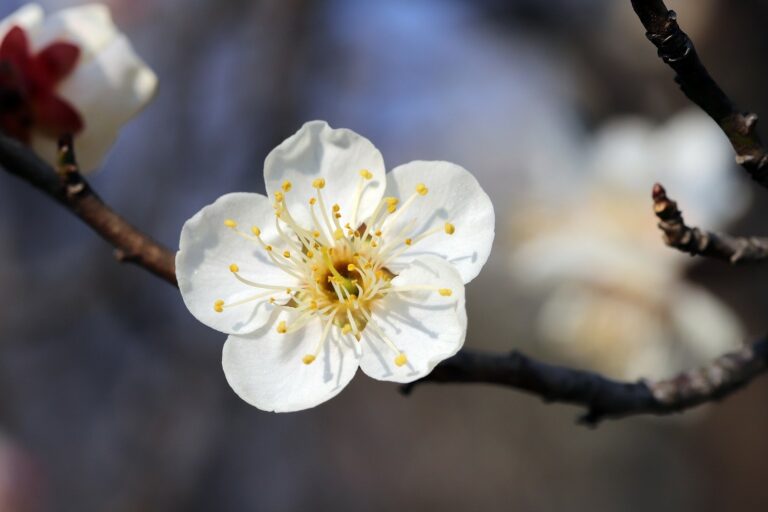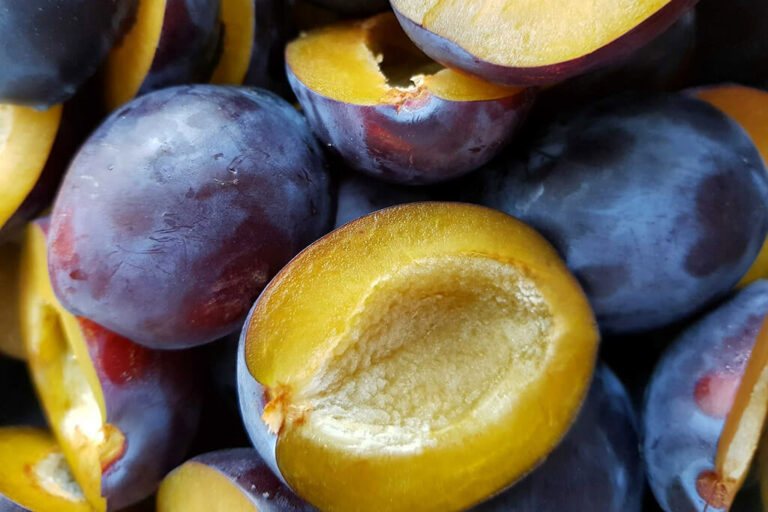Planning your garden is always a fun but tricky prospect. You have to consider what plants thrive in your climate and what will provide beauty and sustenance all season long.
If you’re wondering when do plum trees bloom, you’re in luck! This post will tell you everything you need to know about this beautiful tree and when to expect its blooms. Read on to learn more!
When Do Plum Trees Produce Blossoms?
Plum trees are members of the Prunus genus, which includes other stone fruits such as peaches, cherries, or apricots. There are two common varieties of plum trees in the US – the Japanese plum tree and the European plum tree.
Plums usually blossom between late February and May with some varieties blooming slightly earlier or later depending on their location and climate zone. The Japanese plum trees blossom slightly earlier than the European plums.
There are thousands of plum cultivars out there! Each may have different flowering characteristics so keep this in mind when planning your plum trees.
Depending on the cultivar and climate, plums may begin to fruit roughly May through September.

How Do the Plum Tree Blossoms Look?
The majority of the time, plum flowers are pink or white. Some types feature blossoms that lean more towards the red side of the spectrum.
Most plum blossoms have five petals. They are rounded and unlike cherry blossom petals, they don’t have any spiky features curving inwards at their end.
Plum blossoms also have rounded buds, which is again a distinct feature when compared to cherry buds. Cherry buds are more oval-shaped.
Plum flower buds may look similar to cherry ones at first, but they are smaller and lack the typical stem of cherry flowers. For plums, there’s only one flower in one place while cherry flowers form clusters of flowers growing from one place.
Plum fruit may seem microscopic in size at first, but it can actually grow up to three inches across and weigh almost a half-pound! When plum trees lose their flowers the branches look as if they lost their fruit as well.
How Long Do Plum Trees Bloom?
This will depend primarily on the type of tree you have. Japanese plum trees will typically stay in full bloom for about 10 days while European plum trees will stay in full bloom for about 14 days.
In some cases, plum blossoms can stay on the tree for an extended period of time. This can be due to a variety of factors including bad weather, mismanagement from the gardeners, or simply due to characteristics of the planted cultivar.
Why Do Some Plum Blossoms Fall Off?
Damage to the flowers, either by other plants or due to bad weather conditions can cause them to drop off naturally. Most commonly, the damage is caused by an unexpected late frost.
Disease and natural aging can also cause plum blossoms to fall off the tree, and plum trees that are planted in poorly drained soils may experience poor blooming as well.
What Should You Do if There Is a Late Frost?
The worst thing that can happen to a farmer or gardener is if there is a late frost and the blooms are killed. This can ruin an entire crop! There’s not much you can do if this happens, but it is definitely something to keep in mind when planning your own plum trees at home.
If late frosts are common in your area, chances are you won’t be seeing ripe fruit on your plum trees anytime soon.
If the forecast says there’s frost coming there are several tricks you could try:
- The best trick to prevent frost damage you can try is to cover the tree. You can try covering the tree with a sheet of non-woven fabric, tarp, or pretty much anything you can find that will fit over the tree’s canopy. Obviously, older bigger trees are more difficult to cover than younger ones. When you cover the tree before the frost arrives you are essentially trapping the warmer air under the cover. With some luck, the temperature will stay above the critical level.
- Setting up over smaller trees works very well too.
- Bring in a portable heater and place it near the base of the tree. Make sure to keep a safe distance from the branches and leaves. This trick might only work with small trees.
- Vineyards and orchards fight frost with candles. Hundreds or even thousands of them actually. We cannot really recommend that though because of the risk of fire.

Why Is My Plum Tree Not Blooming?
Sometimes plum trees are not blooming. There may be several factors in play:
- Newly planted trees may start blooming a little bit later than usual.
- Your plum tree needs more sun. Plum trees generally require full sun to bloom and form fruit. Six to eight hours of sunlight a day is the bare minimum to aim for.
- Too much heat may also affect flower production on a particular variety. Some plums have been bred for cold climates and their flowering potential is greatly reduced if grown in warmer environments. The problem is some stores won’t mind selling you varieties that are not suitable for your climate zone.
- Similar to the above, humidity levels that are too low can also have an adverse effect on plum tree flowering.
- Plum trees need water but rainfall may not be enough to ensure good flowering. Irrigation is often needed during bloom time, especially if the weather is dry.
If any one of these conditions exists, plum flower buds formation might be reduced or non-existent.
Did You Know? Fun Facts About Plums
Although the sakura blossoms in Japan are much more famous, the plum tree blossom season is also very popular among tourists.
Plum blossom festivals are held all over Japan. Plum trees were brought to Japan from China more than hundreds of years ago.
Plums are not just for desserts! In Japan, the is among the most popular condiments. The vinegar can be used in salads, in a sauce for fish and meat, or even as a dip for sashimi.
Slivovitz, or a plum spirit, is a popular fruit spirit produced from Damson plums mainly in Central, Eastern, and Southern Europe. It’s widely produced both privately and commercially.
Plums and other fruit trees provide some amazing benefits to the environment. Bees are attracted to their blossoms, and in turn, bees help keep your garden’s ecosystem healthy and functional. Plum trees also help keep your neighborhood cooler and happier and they reduce stress by making us feel good with their beautiful blooms.
Conclusion
Spring is in the air and that means plum blossom season is just around the corner! If you’re like us, you’re probably excited to see the pretty pink, white, and red blossoms on the trees. The blooming period for plum trees usually lasts about two weeks so make sure you get out there and enjoy the beauty while it lasts. We can’t wait to see all of your pictures of plum blossoms this year!
Read more about flowers and seeds:
Where Do Carrot Seeds Come From? Things To Know!
Last update on 2024-06-29 / Affiliate links / Images from Amazon Product Advertising API